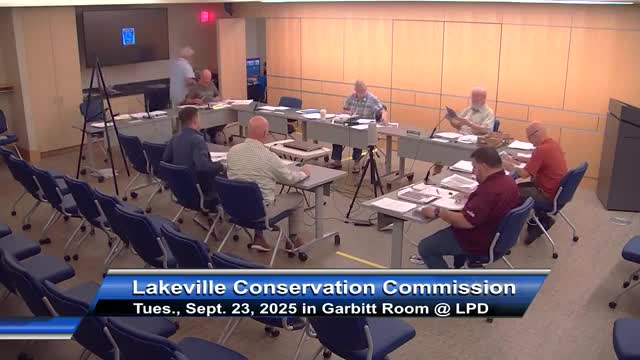Crystal Water Anglers Propose Invasive Species Management for Bridal Water Pond
September 26, 2025 | Town of Lakeville, Plymouth County, Massachusetts
This article was created by AI summarizing key points discussed. AI makes mistakes, so for full details and context, please refer to the video of the full meeting. Please report any errors so we can fix them. Report an error »

Lakeville's Conservation Commission has taken a significant step towards ecological restoration at Bridal Water Pond, a key site for the Crystal Water Anglers club. During a recent meeting, the commission approved a notice of intent for an invasive species management program aimed at addressing problematic vegetation that has been choking the pond's ecosystem.
The proposal includes the application of herbicides and algaecides to combat invasive species such as coontail, bladderwort, and filamentous algae, which have proliferated in the pond. The management plan is designed to restore the balance of native vegetation, which is essential for maintaining a healthy aquatic environment. The chemicals proposed for use have been approved by both the U.S. Environmental Protection Agency and the Massachusetts Department of Agricultural Resources, ensuring their safety for aquatic life.
The commission emphasized the importance of monitoring the pond's health throughout the treatment process. A proactive approach will be taken, with regular assessments to catch any increases in undesirable vegetation early, thereby minimizing the amount of herbicide needed and reducing potential impacts on the ecosystem.
Concerns were raised about the potential effects of the treatment on local fish populations, particularly native brook trout in nearby waters. However, experts assured the commission that the chemicals used would not harm fish if applied correctly. Additionally, the commission mandated that water quality testing be conducted at the outlet to McCoy Brook within 24 hours of treatment to ensure no harmful substances are released downstream.
The commission's decision reflects a commitment to balancing ecological health with recreational use of the pond. The ongoing management plan will not only address current vegetation issues but also establish a framework for future maintenance, ensuring the pond remains a viable habitat for fish and a resource for the community. The commission plans to receive annual reports detailing treatment outcomes and vegetation assessments, reinforcing transparency and accountability in the management process.
The proposal includes the application of herbicides and algaecides to combat invasive species such as coontail, bladderwort, and filamentous algae, which have proliferated in the pond. The management plan is designed to restore the balance of native vegetation, which is essential for maintaining a healthy aquatic environment. The chemicals proposed for use have been approved by both the U.S. Environmental Protection Agency and the Massachusetts Department of Agricultural Resources, ensuring their safety for aquatic life.
The commission emphasized the importance of monitoring the pond's health throughout the treatment process. A proactive approach will be taken, with regular assessments to catch any increases in undesirable vegetation early, thereby minimizing the amount of herbicide needed and reducing potential impacts on the ecosystem.
Concerns were raised about the potential effects of the treatment on local fish populations, particularly native brook trout in nearby waters. However, experts assured the commission that the chemicals used would not harm fish if applied correctly. Additionally, the commission mandated that water quality testing be conducted at the outlet to McCoy Brook within 24 hours of treatment to ensure no harmful substances are released downstream.
The commission's decision reflects a commitment to balancing ecological health with recreational use of the pond. The ongoing management plan will not only address current vegetation issues but also establish a framework for future maintenance, ensuring the pond remains a viable habitat for fish and a resource for the community. The commission plans to receive annual reports detailing treatment outcomes and vegetation assessments, reinforcing transparency and accountability in the management process.
View full meeting
This article is based on a recent meeting—watch the full video and explore the complete transcript for deeper insights into the discussion.
View full meeting
